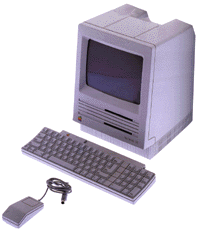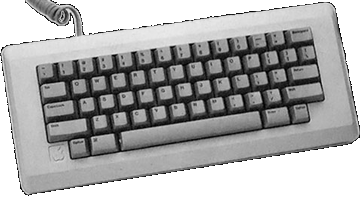Macintosh SE

Essentials
Family: Classic Macs
Codename: Mac ±, PlusPlus, Aladdin, Freeport, Maui, Chablis
Gestalt ID: 5
Minimum OS: System 3.0/Finder 5.1
Maximum OS: 7.5.5
Introduced: March 1987
Terminated: August 1989
Processor
CPU: Motorola MC68000
CPU Speed: 8 MHz
FPU: none
Bus Speed: 8 MHz
Register Width: 32-bit
Data Bus Width: 16-bit
Address Bus Width: 32-bit
ROM: 256 kB
RAM Type: 30 pin SIMM
Minimum RAM Speed: 150 ns
Onboard RAM: 0 MB
RAM slots: 4
Maximum RAM: 4 MB
Expansion Slots: 1 SE PDS
Video
Monitor: 9" built-in
Max Resolution: 1 bit 512x342
Storage
Hard Drive: optional 40 MB
Floppy Drive: 1 or 2 800 kB 3.25"
Input/Output
ADB: 2
Floppy: DB-19
Serial: 2 Mini DIN-8
SCSI: DB-25
Audio Out: mono 8 bit mini
Speaker: mono
Miscellaneous
Power: 100 Watts
Dimensions: 13.6" H x 9.69" W x 10.9" D
Weight: 17 lbs.
Released at the same time as the Mac II, (March, 1987) the Mac SE further addressed the issue of expansion. It came in a new platinum case, had an expansion slot, and included a bay for either a second internal floppy drive, or an internal hard drive. The Mac SE was also one of the first Macs to include an Apple Desktop Bus (ADB), which allowed for up to 16 input devices. It sold for $2,898 for a dual floppy configuration. In August 1989, The SE was replaced by the SE FDHD. Thanks to Eric Rasmussen For OS info.
Picture Credits:
AppleDesign
Date: Tue, 09 May 2000 20:05:00 -0700
From: David Charlap
Subject: Some comments on the Mac SE
My SE has a motherboard dated 1986. It originally shipped with two 800 kB drives and 1 M of RAM.
When I bought it from its original owner, it was upgraded to have 4 MB ofRAM and an internal hard drive. Neither of the original two floppydrives were removed, however!
Whoever added the hard drive added a horizontal bracked above the upperfloppy drive, and mounted a 40 MB drive on it. (There was about 1/4" ofclearance between the drive and the picture tube!) When that hard drivefailed, I replaced the drive with a 200 MB drive. Since the new drive isa 1" tall drive, there is now a little more room between it and themonitor.
I also replaced the floppy drives with 1.44 MB drives (scavenged frombroken SE-FDHD units.) The FDHD systems had motherboards dated 1988. The drives work in my 1986 motherboard, but only after moving the ROMchips from the FDHD system. Without the ROMs, the SE would treat the HDdrives as 800 kB drives - it wouldn't generate any errors, it would justformat the HD media as 800 kB and use it as such.
The 1986 motherboards have the clock battery soldered to themotherboard. The 1988 motherboards have it in a socket. (I believeit's an "N" size battery.)
I think all SEs manufactured after 1988 included the 1988 motherboardand ROMS, including the ones that shipped with 800 kB floppy drives. Atleast I found several like that when going through a dozen brokenmachines to scavenge the two HD floppy drives that my SE has in it.
The models with the first-generation motherboard also have thedevelopers' signatures embossed on the inside of the case.
FWIW, last week, at a flea market, I was able to find an AsanteMacCon+SE Ethernet board. I installed it into the motherboard'sexpansion slot, and mounted the tranceiver onto the frame next to aknockout panel in the case. It was a very tight fit, given the presenceof three internal drives, but it does all fit together.
So....
My SE, which I still use, is equipped thusly:
- 1986 motherboard (original series, with battery soldered to the board)
- 4 MB RAM
- 1988-generation ROMs (supporting HD floppies)
- 2 1.44 MB floppy drives (internal)
- 200 M hard drive (internal)
- 10 Mbps Ethernet (internal)
It successfully runs MacOS version 7.5. The most modern program I haverun on it is Claris FileMaker Pro version 2.1. It runs fine, althoughit is (understandably) quite a bit slow.
-- David
